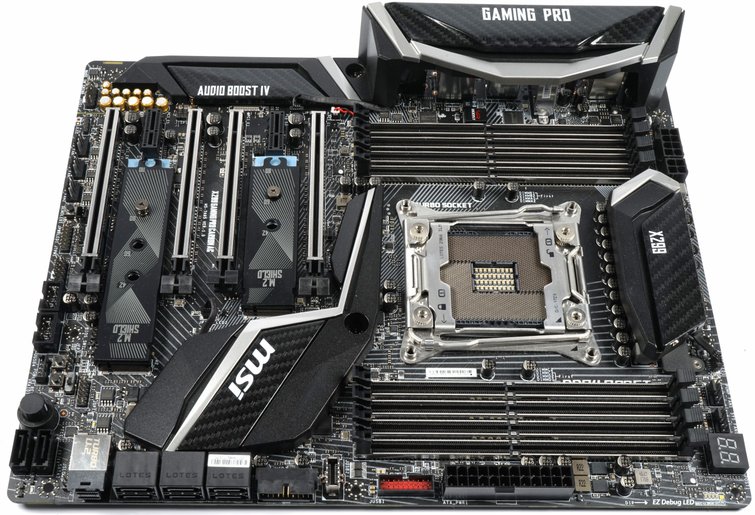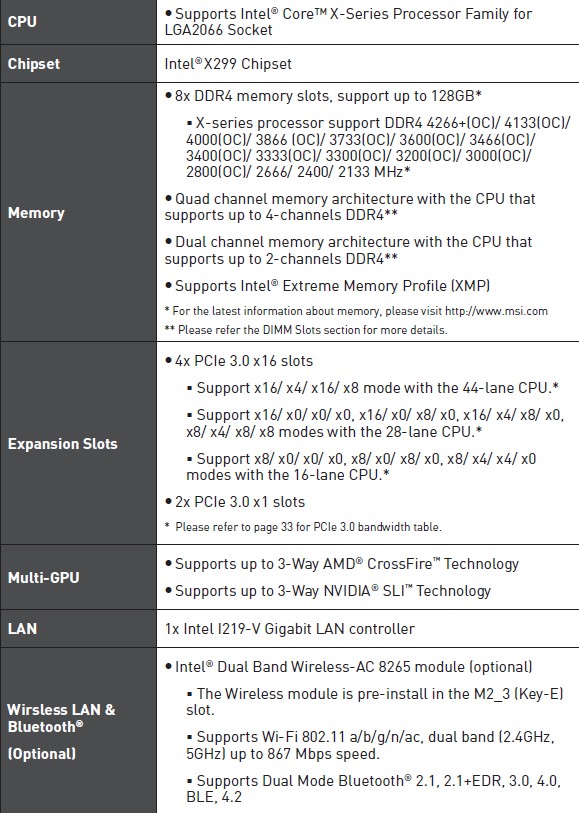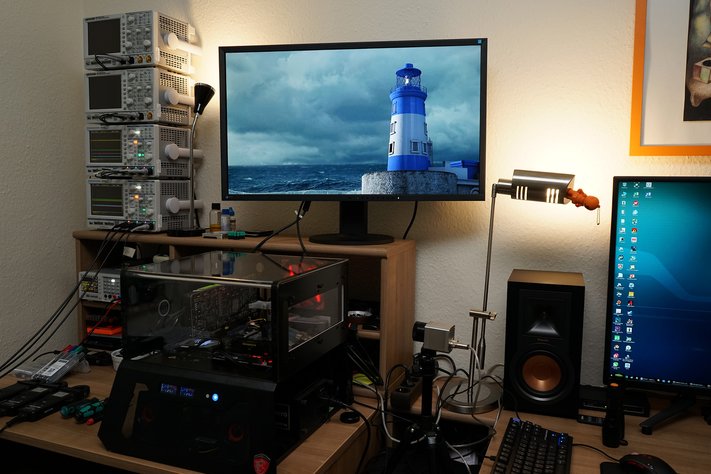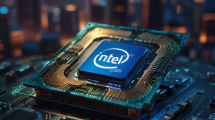The Basin Falls X299 chipset
The Kaby Lake-X and Skylake-X processors sit in an LGA2066 socket (R4), powered by a 6 watt X299 chipset, underscoring Intel's strategy of using server chipsets for their HeDT (High End DeskTop) lineup. The 14nm chiset supports an x4 DMI 3.0 connection, which is similar to a PCIe link between the processor and the chipset. This results in an increase in throughput compared to broadwell's DMI 2.0 connection by a whopping 2GB/s. Basin Falls also supports 30 HSIO (High-Speed I/O) lanes, which equates to a total of 68 available lanes for the high-end models.
This allows motherboard manufacturers to natively realize up to eight SATA 3.0 and 10 USB 3.0 ports, but X299 does not require a native implementation of Thunderbolt 3 and USB 3.1 Gen 2. Intel, however, plans to do so later for upcoming chipsets. For this purpose, X299 already supports up to three RST PCIe 3.0 x4 storage media, with many of the Skylake-X and Kaby Lake-X CPUs can't take advantage of this due to your PCI lane limitations.
The socket LGA2066 of course has more pins than the LGA2011 v3, but the external dimensions of the CPU have remained the same. The advantage is that all previously suitable coolers can still be used, at least in terms of assembly technology. However, Intel now even recommends water cooling for use in higher TDP CPUs, which of course increases the cost of this platform again.
Like all Skylake-X CPUs, the Core i7-7900X comes to the customer as a tray version and thus without a cooler. In addition, these CPUs have an IVR (Integrated Voltage Regulator) that roughly corresponds to the FIVR implementation of the Broadwell-E. Unfortunately, Intel hasn't released any more specific specifications yet, but it suggests a new thermal overhead. Intel offers for approx. 100 Euro perspective with the TS13 own AiO compact water cooling, but if you really seriously think about overclocking, you should plan a proper custom-loop water cooling in the budget.
The MSI X299 Gaming Pro Carbon AC
The MSI motherboard we use is not the top-of-the-range model from the Taiwanese manufacturer, but it is certainly well suited to gain initial experience with the X299 chipset. We have also been able to eliminate problems and bottlenecks that occur together with MSI during the tests and have therefore had to repeat certain benchmarks several times, which has taken an enormous amount of time.

The board supports all current CPUs with the Socket 2066, including the Kaby Lake-X models. Note the connection of the PCIe expansion slots, which depend on the model and the available lanes (44, 28 and 16 at Kaby Lake-X). A triple crossfire or SLI is easily possible in theory, but in practice we would rather advise against such a constellation.

The variety of connections is sufficient and the board also dispenses with overly intrusive illumination. Some light is also present here, but it remains within the bounds of what is tolerable. The board has an 8-pin EPS connector, which is complemented by another 4-pin connector, which is also urgently needed at the latest with the Core i9-7900X. We are already applying the following part with the power recording, because it will be exciting and in the end even quite tight.

In this context, we also refer to the introduction of the following page on benchmarks, where we will return to the problem of switching from ringbuses to mesh. However, the performance increases over the course of the two BIOS updates were really significant and we can only be surprised at the hastily leaked reviews of some media before the NDA case, which in the end cannot reflect what is Skylake-X (currently) is really capable of offering.
Power consumption test system, workstation and HPC benchmarks
The new test system and the methodology we have already described in great detail in the basic article "So we are testing graphics cards, as of February 2017" and so we now only refer to this detailed description for the sake of simplicity. So if you want to read everything again, you are welcome to do so.

In this case, only the hardware configuration with CPU, RAM, motherboard, as well as the new cooling is different, so that the summary in table form quickly gives a brief overview of the system used here and today:
| Test systems and measuring rooms | |
|---|---|
| Hardware: |
Intel Socket 2066 Intel Core i9-7900X MSI X299 Gaming Pro Carbon AC 4x 4 GB G.Skill RipJaws IV DDR4-2600 AMD Socket AM4 Workstation Intel Socket 2011v3: Intel Socket 1151: All systems: 1x 1 TByte Toshiba OCZ RD400 (M.2, System SSD) Be Quiet Dark Power Pro 11, 850-watt power supply |
| Cooling: |
Alphacool Ice Age 2000 Chiller Alphacool Ice Block XPX Thermal Grizzly Kryonaut (for cooler change) |
| Monitor: | Eizo EV3237-BK (Workstation, Office, HPC) |
| Power consumption: |
non-contact DC measurement on the PCIe slot (Riser-Card) non-contact DC measurement on the external PCIe power supply Direct voltage measurement on the respective feeders and on the power supply 2x Rohde & Schwarz HMO 3054, 500 MHz multi-channel oscillograph with memory function 2x Rohde & Schwarz HZO50, current pliers adapter (1 mA to 30 A, 100 KHz, DC) 2x Rohde & Schwarz HZ355, probe divider (10:1, 500 MHz) 1x Rohde & Schwarz HMC 8012, digital multimeter with storage function |
| Thermography: |
Optris PI640, infrared camera PI Connect evaluation software with profiles |
- 1 - Einführung und Übersicht
- 2 - Intels Fabric - Mesh statt Ringbus
- 3 - Cache und Latenzen, IPC, AVX und Kryptographie
- 4 - Chipsatz, Testsystem und -methoden
- 5 - Problemanalyse mit Civilization VI und VRMark
- 6 - AotS Escalation, Battlefield 1, Deus Ex: Mankind
- 7 - GTA V, Hitman, Shadow of Mordor
- 8 - Project Cars, Rise of the Tomb Raider, The Division
- 9 - Workstation und HPC
- 10 - Leistungsaufnahme und Übertaktung
- 11 - Temperaturverläufe und thermische Probleme
- 12 - Zusammenfassung und Fazit

































Kommentieren